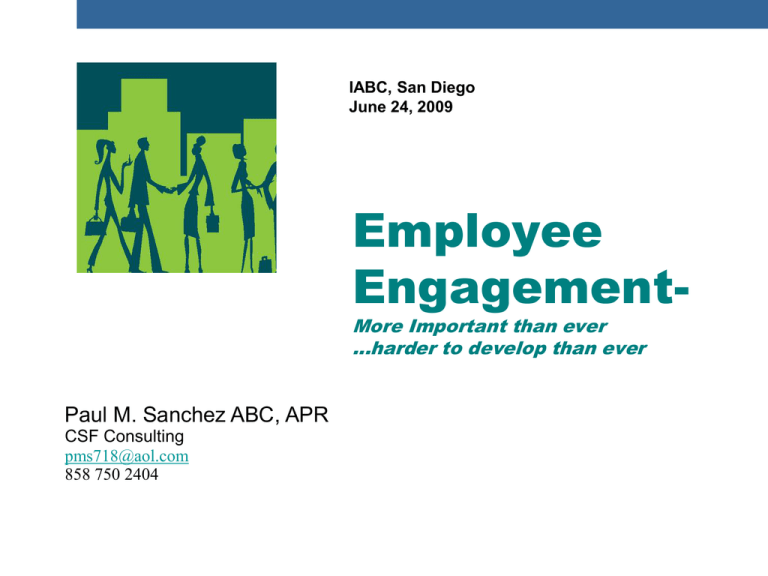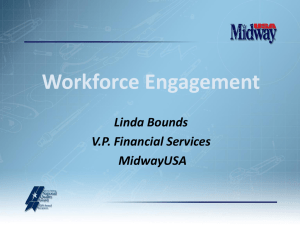Employee Engagement
advertisement

IABC, San Diego June 24, 2009 Employee EngagementMore Important than ever …harder to develop than ever Paul M. Sanchez ABC, APR CSF Consulting pms718@aol.com 858 750 2404 Overview We will cover: n From satisfaction to engagement n Defining employee engagement n The rise of engagement studies n Engagement measurement n Stages of engagement n Why pay attention to engagement n Engagement planning implications Session guidelines …according to Andrea n n n To explore the topic of employee engagement – and have three “take-aways” To have three “give-aways” Share a real-life “Engagement” success story along the way…Southwest Airlines From Satisfaction to Engagement From Satisfaction to Engagement Over the last couple decades, employers’ focus has moved beyond just “satisfied” or “committed” employees, to employees who are “engaged” 1980s 1990s Satisfaction Commitment Satisfied with pay, benefits, supervisor, working conditions, etc. + Not considering leaving the organization 2007? Engagement + Willing to go the “extra mile” Defining Employee Engagement Defining Employee Engagement T-A n Engagement is the result of how employees feel about the work experience–about their employer, its leaders, the work and the environment n Employee engagement drives discretionary behaviors: – To be advocate for the organization – Willingness to go the extra mile – Motivation to perform to the highest standards – Creative energy applied to their work – Mutual and vested interest in the company’s success as well as one’s team and self T Employment Value Chain From Strategy to Performance Results Business Environment Company Strategy Brand values Human Capital & Communication Strategy Employee Perceptions & Behaviors Business Performance - Customer Satisfaction - Performance - Quality Metrics - Employee Retention 8 From Satisfaction to Engagement Research1 has established that work environment and resulting perceptions drive behaviors that bear on performance outcomes Satisfaction, Commitment and Engagement 1 Productivity Customer Satisfaction Safety Behavior Employee Retention See, for example, Harter, J.K., Schmidt, F.L., & Hayes, T.L. (2002). Business-unit-level Relationship Between Employee Satisfaction, Employee Engagement, and Business Outcomes: A Meta-Analysis. Journal of Applied Psychology, 87(2), 268-279. Organization Performance A Winning Employee Experience Drives Key Business Outcome T-A Research demonstrates that high levels of engagement (typically 60% or more) create positive employee outcomes which, in turn, drive business results Highly Engaged Companies 44% higher Retention 29% higher in Revenue 70% more Productive Engaged employees: 56% higher Customer Loyalty 50% higher in Customer Loyalty 34% higher Customer Satisfaction increased performance of up to 20 percentile points 50% higher Safety 44% higher in Profitability 30% more Productive 80% fewer Union Grievances are 87% less likely to leave an organization 33% more Profitable National Research Forum (2004) Izzo & Withers (2000) Vance (2006) Corporate Leadership Council (2004) 10 Falling Levels of Engagement n In the past six to nine months– at least four major consulting firms issued reports about Engagement and related topics – – – – – n Buck/IABC/RF Towers Watson Wyatt Mercer Studies report similar elements First hand reports of the toll on the workforce – – – – – Happy to have a job, Distrustful of management, Will do the what it takes—just Head down Concerned about extra workload Employee Engagement Index and Drivers of Engagement Engagement and Drivers Employee Engagement Index generally are comprised of five items: Employee Engagement Index 1. I feel a strong sense of commitment to this company. 2. I am proud to work for this company. 3. I would recommend my organization to others as a good place to work. 4. I am not considering leaving this company in the next 12 months. 5. I am willing to go “above and beyond” in my job to help this company be successful. Drivers of Engagement Once indexed, need to know what drives engagement? The experience of: Strategy Structure Processes …and other People Identified and analyzed Six factors Twelve + dimension Fifty to sixty “items” How is an engaged workforce visible? What would employees say when asked: “What’s it like to work here?” • Employees act like owners • We want to have a sense of fun in our work • Employees are also important customers • When we take care of employees they take care of customers • Quality and customer service are first in our minds Whatever you do, do it at Microsoft. • We’re the best and brightest • We’re different from everyone else • We may be geeks, but we’re rich • We’re a place where innovation is valued • We care about rewarding people for creativity in the work place 15 Engagement Stages From Satisfaction to Engagement Employee Engagement Model© with four phases or facets: Engagement Model Committed Advocate Motivated Satisfied Disengaged Satisfied Satisfied n n n n n n Enjoys job Is not dissatisfied with terms and conditions Content to work alone Does not go “above and beyond” Not necessarily a team player Often focused outside of work Motivated Motivated n n n n n Contributes energetically Strives to achieve personal goals Values achieving personal goals more than team/organizational goals Focused individual contributor More loyal to personal professional goals rather than organization Committed Committed n n n n n n Loyal to organization, optimistic for the future Sees the bigger picture with a sense of how job fits in Collaborates to achieve team goals Openly ambitious for self, team and company Believes the organization will enable his/her good performance Has a sense of belonging to organization–feels valued and involved at work Advocate Advocate n n n n n n Contributes discretionary effort Proactively seeks opportunities to serve the mission of the organization Speaks positively about the organization’s products, services and people Recommends organization as an employer Is willing to withhold criticism and/or be constructively critical for the good of the organization Resilient to short-term dissatisfiers Why do organizations need to pay attention to engagement now? n n n n n General uncertainty in the economy Employees face worry at work and at home—can lead to reduced job focus Customers/clients cut back, actual environment grows more competitive Employees are oriented, trained, and motivated through a spectrum of experiences that ultimately shape how customers/clients are treated Failure to win the hearts and minds of employees put all customer/client interactions at risk 26 Core Engagement Elements and Implications and Possible Action Points Leadership Acts in accord with the expressed values of the organization Allocates resources in ways that support strategy Visible & transparent involvement with the customers and employees Making the connections between strategy and process that will aid employees in seeing the big picture Recognition and Rewards Reward practices that are perceived as fair and competitive Total compensation approach (bringing it all together) Benefits components integrated with the total reward package Employees recognized in tangible and immediate ways Exploration of non-cash recognition for outstanding performance The Work Itself Treated with respect Work valued for overall contribution Opportunity to grow in job and laterally Work aligned with the success of the enterprise Participating in developmental opportunities Communication Organization culture that is built on a two-way exchange of information Communication that is planned Supervisors are active participants in the cascade of information Full mix of media to reach all levels of the organization Communication training for supervisors Engaged Employee Experience System typical drivers Common Operating Drivers* n Confidence and trust in CEO/leadership n Leadership visibility and communication n Line of sight between individual performance and company performance n Career growth and development opportunities n Communication’s program n Relationship with supervisor n Recognition and rewards Employee Engagement *Based on Mercer HR study 28 Why employers fail to build engagement programs Importance “Too not clear difficult” Satisfaction surveys and customer research often did not emphasize importance employee’s role Responsibility for engagement is seen as too diffuse to assign, manage or measure “Too Remedy expensive” not clear Building an engaged workforce may be seen as a luxury the company cannot afford Improving employee engagement means understanding the specific and unique drivers of engagement 29 Winning employee support Employees Employees Employees Employees unaware hostile not not able motivated Provide information and training to build knowledge of touch-points and positioning Provide information and training about the mutual interests between org. employees and clients/customers Institute recognition & reward programs that support quality and service goals Develop skills and processes to design and deliver winning customer/client service Communications & HR Programming Attitudes Behaviors 30 The Employee Experience: what employees report Source “What’s Working” Mercer Global Report on Engagement 2007 Company Pride % Favorable Organization has good reputation for “customer” service Feedback from customers used to improve products and services 70 59 32 Commitment % Favorable I feel a strong sense of commitment to my organization I would recommend my organization to others as a good place to work 62 59 33 Starting with vision and values Regarding values % Favorable Vision and values have been clearly communicated 62 Values provide direction for employees Management behavior is consistent with the organization’s values 53 45 34 Communication and leadership % Favorable Communication about the future direction of organization Trust in management communication 52 39 35 Upward Communication % Favorable My manager encourages open, honest two-way communication I feel encouraged to come up with new and better ways of doing things 67 51 36 The Employee Experience: what employers can do Employee Engagement process Research Planning Testing Review and Development of Test concepts with analyze key data cross-functional employee groups points – employee team (Coms, HR, from Customer surveys, workforce Operations) Service, Mfg. IT, analytics, Retail Sales and Confirm and refine competencies, Business Sales working demographics, assumptions Adjust elements external brand based on testing research, etc. Identify key employee groups Review and adjust Analyze data for for testing further with preliminary Discovery Team “working” plan Identify preliminary sub-group areas of alignment and misalignment (sample plan) Implementation Align with HR, Mktg and Ops. marketing action plans to begin the process of developing a more engaged workforce Gain leadership support Confirm metrics for success/ROI 38 Translating Engagement to Communications Messages Communication Stakeholders n What is happening and why? n Future vision? Senior executives n Why are we doing this now? Most valued employee Managers n How will I be affected? n What do I need to do to help? Culture and employer brand HR, Comms, Marketing n What do I need to do differently? n How will I be measured? n What training/career development Supervisors opportunities are there? External centres of influence n What support/resources will I have? n How will I be rewarded? n What am I worth to the company? 39 If You Work on Engagement, Will It Payoff? n n n Collective problem solving Improved performance/customer/client service, hence customer loyalty, profitability and (ultimately) share price Internal brand recognition/third party attention – new hire interviews – positive press mentions, – best employer lists n n Employee innovation, enthusiasm and willingness to go that extra-mile Ability to hold critical skills; and reduction in early attrition and later turnover 40 Conclusion (Action Areas) Critical success factors: n How the mission is framed and internalized for employees n How values are lived (made apparent) by leaders and managers n How customer input information is used n How employees are treated – Two-way communication environment – Recognition – Rewards – cash, benefits, development, affiliation – Career paths 41 IABC, San Diego June 24, 2009 Employee EngagementMore Important than ever …harder to develop than ever Paul M. Sanchez ABC, APR CSF Consulting pms718@aol.com 858 750 2404


